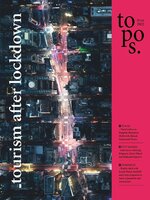Topos is a must-have for successful landscape architects, planners, urban designers and architects all over the world.The monothematic issues provide a global overview of innovative projects, new developments and trends in the profession. Be part of the worldwide community of Topos readers!
THE INTERNATIONAL REVIEW OF LANDSCAPE ARCHITECTURE AND URBAN DESIGN
Editor’s Note
TRAPPED IN UTOPIA – THE SINISTER PLOT BEHIND THE 15-MINUTE CITY
We’ll always have Paris
Oxford • Oxford is internationally known not only for its university – but now also for protests against the 15-minute city. These took place in 2022 and 2023, but were actually only falsely directed against the urban planning concept. We take a look at the measures intended by the city that triggered the protests, the role that conspiracy theories played and how the city reacted
COBE
Urban madness • You’ve just spent 45 minutes in traffic to attend a meeting about sustainable urban mobility. Ironic? Entirely. Somewhere between the commuter chaos and yet another “smart city dashboard” a radical idea emerges: what if everything you needed was just 15 minutes away? The 15-minute city sounds suspiciously like common sense - until you try to build it. But behind the buzz lies a serious rethink of zoning, access, and how digital tools can make proximity not a privilege, but a right. From Paris to Bogotá, this article unpacks the promise, the pitfalls, and the poetry of designing life at human scale.
"MORE SUSTAINABLE, RESILIENT AND PEOPLE-URBAN ENVIRONMENTS" • The concept of the ‘15-minute city’ has caused a worldwide sensation - from Paris to Portland - and stands for a radical reorganisation of urban life: short distances, diverse use, strong neighbourhoods. In this interview, Moreno explains how urban spaces can be designed in a socially just way and why his vision is far more than just urban planning, namely a cultural change.
A CITY FOR PEOPLE • The future of mobility is the subject of much discussion everywhere. Driving bans and speed limits are often met with resistance. However, a project in Spain shows how a resolute concept can sustainably improve inner-city quality. The city centre of Pontevedra has been largely car-free for just over 25 years. A look at restrictive measures and courage in this small town in Galicia.
"IT IS ABOUT THESE STREETS RECOVERING LIFE" • Pontevedra in Spain is a pioneer of the 15-minute city. Mayor Miguel Fernándes Lores has managed to create safe spaces and bring more life to the streets and public squares. In this interview, he explains how Pontevedra has implemented the concept.
TOGETHER, LET’S INVENT THE LIFE OF TOMORROW • What role does proximity play in our daily lives? While the past century was significantly shaped by the concept of the 'car-friendly city', more and more cities are now aiming for a '15-minute city'. This model envisions urban environments where all key daily necessities are reachable by a 15-minute walk from one’s place of residence. Hereby, the city of Nantes in France is emerging as a frontrunner.
"CITIZEN PARTICIPATION IS AT THE HEART OF THE 15-MINUTE CITY" • Paris is consistently embracing the 15-minute city concept to redesign its urban space. The historically evolved structure of the French capital, with its density and infrastructure, offers ideal conditions for this transformation. Major projects such as the redesign of Place de la Concorde combine cultural heritage with contemporary utilisation concepts. Alexandre Labasse, Director General, and Patricia Pelloux, Deputy Director of the Parisian urban planning office Apur, explain how Paris is mastering the balancing act between local supply and metropolitan appeal.
PROS AND CONS
THE 20-MINUTE NEIGHBOURHOODS • Located among the rivers and forests of the...

 N. 131
N. 131
 N. 130
N. 130
 N. 129
N. 129
 N. 128
N. 128
 N. 127
N. 127
 N. 126
N. 126
 N. 125
N. 125
 N. 124
N. 124
 N. 123
N. 123
 N. 122
N. 122
 N. 121
N. 121
 N. 120
N. 120
 N. 119
N. 119
 N. 118
N. 118
 N. 117
N. 117